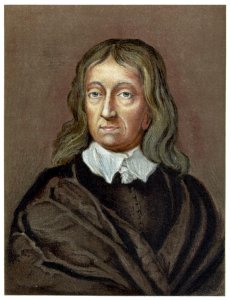The directory «Plots»
Milton John
(1608–1674)

English poet, b. London, one of the greatest poets of the English language.
The son of a wealthy scrivener, Milton was educated at St. Paul’s School and Christ’s College, Cambridge. While Milton was at Cambridge he wrote poetry in both Latin and English, including the ode “On the Morning of Christ’s Nativity” (1629). Although the exact dates are unknown, “L’Allegro” and “Il Penseroso” were probably written not long after this. His dislike of the increasing ritualism in the Church of England was the reason he later gave for not fulfilling his plans to become a minister. Resolved to be a poet, Milton retired to his father’s estate at Horton after leaving Cambridge and devoted himself to his studies. There he wrote the masque Comus (1634) and “Lycidas” (1638), one of his greatest poems, an elegy on the death of his friend Edward King.
In 1638 Milton went to Italy, where he traveled, studied, and met many notable figures, including Galileo. Returning to England in 1639, he supported the Presbyterians in their attempt to reform the Church of England. His pamphlets, which attacked the episcopal form of church government, include Of Reformation in England (1641) and The Reason of Church Government Urged against Prelaty (1642).
In 1643 Milton married Mary Powell, a young woman half his age, who left him the same year. Disillusioned by the failure of his marriage, he started work on four controversial pamphlets (1643–45) upholding the morality of divorce for incompatibility. His Areopagitica (1644), one of the great arguments in favor of the freedom of the press, grew out of his dissatisfaction with the strict censorship of the press exercised by Parliament.
Milton gradually broke away from the Presbyterians, and in 1649 he wrote The Tenure of Kings and Magistrates, which supported the Independents who had imprisoned King Charles in the Puritan Revolution. In it he declared that subjects may depose and put to death an unworthy king. This pamphlet secured Milton a position in Oliver Cromwell’s government as Latin secretary for foreign affairs, and he continued to defend Cromwell and the Commonwealth government in his Eikonoklastes [the image breaker] (1649)—an answer to Eikon Basilike—and in the Latin pamphlets First Defense of the English People (1651), Second Defense of the English People (1654), and Defense of Himself (1655).
In the midst of his heavy official business and pamphleteering, Milton, whose sight had been weak from childhood, became totally blind. From then on, he had to carry on his work through secretaries, one of whom was Andrew Marvell. Mary Powell returned to Milton in 1645 but died in 1652 after she had borne him three daughters. He married Catharine Woodcock in 1656, and she died two years later. She is the subject of one of his most famous sonnets, beginning, “Methought I saw my late espoused saint.” In 1663 he married Elizabeth Minshull, who survived him. Milton supported the Commonwealth to the very end. After the Restoration (1660) he was forced into hiding for a time, and some of his books were burned. He was included in the general amnesty, however, and lived quietly thereafter.
For many years Milton had planned to write an epic poem, and he probably started his work on Paradise Lost before the Restoration. The blank-verse poem in ten books appeared in 1667; a second edition, in which Milton reorganized the original ten books into twelve, appeared in 1674. It was greatly admired by Milton’s contemporaries and has since then been considered the greatest epic poem in the English language. In telling the story of Satan’s rebellion against God and the story of Adam and Eve in the Garden of Eden, Milton attempted to account for the evil in this world and, in his own words, to “justify the ways of God to man.”
Paradise Regained, a second blank-verse poem in four books, describes how Jesus, a greater individual than Adam, overcame the temptations of Satan. In both works, Milton’s characterizations of Satan, Adam, Eve, and Jesus are penetrating and moving. Indeed, his portrayal of Satan is so compelling that many 19th-century critics maintained that he rather than Adam was the hero of Paradise Lost. In these two great works Milton’s language is dignified and ornate, replete with biblical and classical allusions, allegorical representations, metaphors, puns, and rhetorical flourishes. Samson Agonistes, a poetic drama modeled on classical Greek tragedy but with biblical subject matter, appeared together with Paradise Regained in 1671.
Milton’s theology, although in the Protestant tradition, is extremely unorthodox and individual on many points; it is set forth in the Latin pamphlet De doctrina Christiana [on Christian doctrine]. Unpublished during Milton’s lifetime, this work was discovered and published in 1825. Milton also wrote 18 sonnets in English and 5 in Italian, which generally follow the Petrarchan style and are accepted as among the greatest ever written.
Great Britain, 2010, John Milton, Vanbrugh house
Hungary, 1967, Milton by Orlai Petrich
USSR, 1958, John Milton
Great Britain, 2010.06.15,  Royal Oak, Filey. Words of Milton
Royal Oak, Filey. Words of Milton